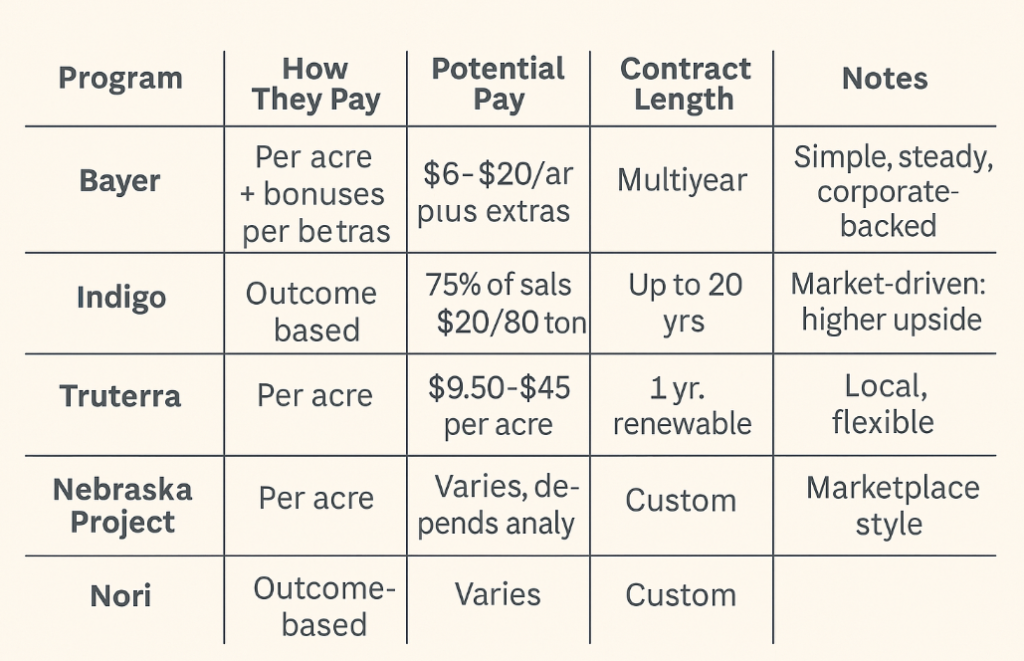Carbon programs are the latest way companies are trying to pay farmers for good conservation practices. The idea is simple: plant cover crops, reduce tillage, manage nitrogen smarter, and get paid for either the practices themselves or the carbon your ground stores.
Sounds good on paper, but every program plays by its own rules. Some pay per acre, some per ton, and some have contracts longer than most tractor loans. Before you jump in, here’s what you need to know.
The Economics of Carbon Practices
Here’s the blunt truth: carbon programs won’t make you rich. Most pay $6-$20 per acre for practices or $15-$30 per ton of carbon. Some outcomes-based markets (Indigo, Nori) have paid higher when credits sold strong ($60-$80/ton), but those prices swing.
On the expense side:
- Cover crop seed runs $25-$35/acre depending on the mix
- Seeding costs another $10-$20/acre unless you do it yourself
- No-till or strip-till may save on fuel and labor, but can require new attachments or a strip-till bar
For some farmers, payments offset part of the cost. For others, especially smaller acreages, it may not pencil out unless there’s a bonus or retroactive payment. Think of it as a cost-share program with paperwork.
What Equipment Do You Need?
Cover crops and reduced tillage aren’t brand-new ideas, but doing them at scale takes the right tools.
Cover Crops
- Drills: Deere 750/1590, Great Plains, Case IH 5400 – reliable for cereal rye or mixes
- Air Seeders: Deere 1890, Bourgault, Salford – cover big acres fast
- Interseeders/High Clearance: Hagie, Miller, or converted sprayers with seed boxes – handy for seeding into standing crops
No-Till & Strip-Till
- No-Till Drills & Planters: Deere MaxEmerge with no-till coulters, Kinze, Case IH Early Riser setups
- Strip-Till Bars: Orthman 1tRIPr, Kuhn Krause Gladiator, Dawn Pluribus, Yetter – make a clean strip while leaving residue in between
- Add-Ons: Residue managers, row cleaners, and down-pressure systems help in heavy residue or tough soils
Many farmers start by renting equipment or adding attachments before investing in full-blown strip-till or interseeding rigs.
Program Options in 2025
Here’s the lineup of the main programs available to farmers in Illinois, Indiana, Iowa, and Nebraska this year.
Bayer Carbon Program – Grow Green, Earn Green
Pays by practice (no-till, strip-till, cover crops).
- $6/acre per practice
- $12/acre for stacked practices
- 2025 Bonus: $15/acre for cover crops on corn, $20/acre with no-till/strip-till
- Historical payments: up to $48/acre for practices from 2021-2024
- Nitrogen add-on: $4/acre for cutting N by 5% with inhibitors
- Contracts: 5 years, renewable up to 20
Indigo Ag – Carbon by Indigo
Pays based on carbon credits sold.
- Farmer keeps 75% of sales
- Credits have sold $20-$80/ton
- Contracts: Multiyear, verified by third parties
Truterra (Land O Lakes)
Pays per ton, not per acre.
- $15-$30/ton
- Can pay retroactively
- Contracts: Reporting period up to 20 years
Nebraska Soil Carbon Project (The Nature Conservancy)
Nebraska-only, pays by acre.
- $9.50-$45/acre annually
- Practices: cover crops, reduced tillage, diverse rotations
- Contracts: 1 year, renewable
Nori Marketplace
Marketplace model, sell direct to buyers.
- Paid per ton of verified carbon
- Prices vary with buyers and demand
- Contracts: Flexible, custom per deal

Final Thoughts from the Field
Carbon programs aren’t a silver bullet.
- If you want steady payments and can live with long contracts, Bayer is easy.
- If you want upside (and can handle the gamble), Indigo and Nori follow the carbon market.
- If you want flexibility, Nebraska’s project is short-term and renewable.
- If you’ve already been doing cover crops or no-till, Truterra may finally pay you for it.
The truth is, for most of us it’s not about striking it rich. It’s about offsetting costs, maybe getting rewarded for practices we’re already trying, and seeing if these programs fit into our operation. Some will work, some won’t. Either way, it pays to know what’s on the table.

